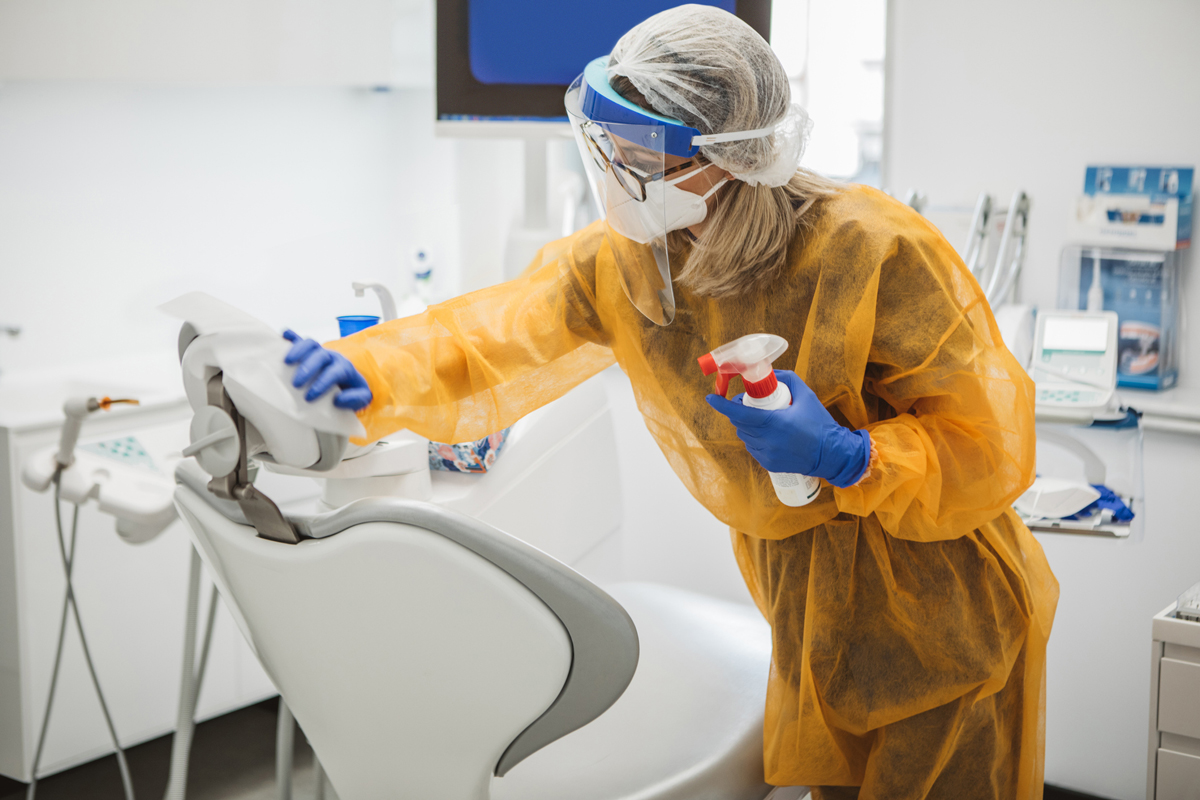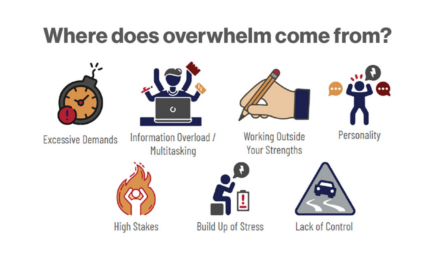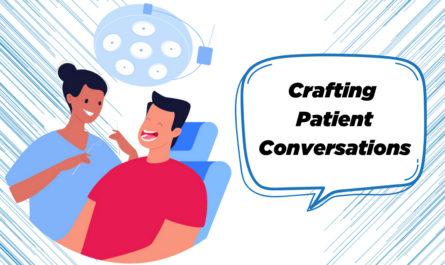By Katherine Schrubbe, RDH, BS, M.Ed, PhD
What does it mean for dentistry?
When was the last time you learned a new word, term, or phrase? As adults, dental clinicians, and science-based individuals, there is likely a set of favorite verbiage you use in daily conversation with family or friends, and another set you use in the clinical dental setting with colleagues, team members, and patients. It has been a long time since there was a new term introduced to dentistry, but with the onset of SARS-CoV-2 and COVID-19 disease, Universal Source Control is a need-to-know essential medical term and its implementation is critical to mitigate the spread of SARS-CoV-2 in dental settings and as a global pandemic.
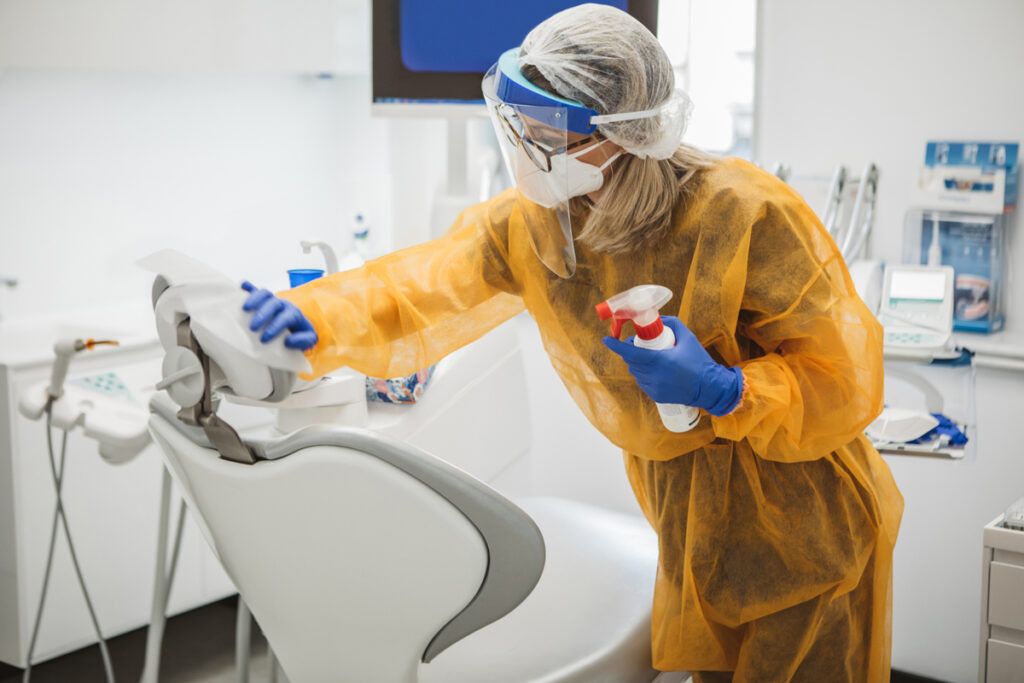
What it isn’t…
Although some may assume so, universal source control is not synonymous with universal precautions. On Dec. 6, 1991, the Occupational Safety and Health Administration (OSHA) promulgated the Bloodborne Pathogens (BBP) standard; designed to protect workers from the risk of exposure to bloodborne pathogens, such as the Human Immunodeficiency Virus (HIV) and the Hepatitis B Virus (HBV).1 The BBP standard introduced the term universal precautions, which is an approach to infection control where all human blood and certain human body fluids are treated as if known to be infectious for HIV, HBV, and other bloodborne pathogens.2 Justification for this concept is based on the inability to easily identify patients who may be infected with HIV, HBV or Hepatitis C (HCV)3; but this is not what universal source control is all about.
In 1996, the Centers for Disease Control and Prevention (CDC) introduced the term Standard Precautions by blending major features of universal precautions and body substance isolation practices to be used with all patients at all times; this included three transmission-based precaution categories: airborne, droplet, and contact.4 Standard precautions apply not just to contact with blood but also to 1) all body fluids, secretions, and excretions (except sweat) regardless if they contain blood, 2) nonintact skin and 3) mucous membranes3; but this is not what universal source control is all about either.
Universal source control
What does this new term have to do with the current SARS-CoV-2 pandemic? The most up-to-date Interim Infection Prevention and Control Guidance for Dental Settings During the Coronavirus Disease 2019 (COVID-19) Pandemic was on Aug. 28, 2020 and lists universal source control as a key concept.5 Universal source control refers to use of cloth face coverings or face masks to cover a person’s mouth and nose to prevent spread of respiratory secretions when they are talking, sneezing, or coughing. Because of the potential for asymptomatic and pre-symptomatic transmission, source control measures are recommended for everyone in a healthcare facility, even if they do not have symptoms of COVID-19.5,6
As an integral part of the healthcare team, dental health care personnel (DHCP) have been wearing face masks and other appropriate personal protective equipment (PPE) for many years, and especially since the BBP standard.2 In training and education program, DHCP are taught to practice under the premise that any patient in the chair is potentially infectious – it is one of the practices they do best – wear PPE appropriately and consistently. So, what is different now?
CDC Dental Guidance
As a key concept for DHCP during this COVID-19 pandemic, the CDC states that DHCP should wear a face mask or cloth face covering at all times while they are in the dental setting, including in breakrooms or other spaces where they might encounter co-workers. This is a change for all DHCP who are used to donning PPE primarily for patient care, however the CDC provides distinct directives for this new practice in dental settings:5
- When available, surgical masks are preferred over cloth face coverings for DHCP; surgical masks offer both source control and protection for the wearer against exposure to splashes and sprays of infectious material from others,
- Cloth face coverings should NOT be worn instead of a respirator or facemask if more than source control is required, as cloth face coverings are not PPE,
- Respirators with an exhalation valve are not currently recommended for source control, as they allow unfiltered exhaled breath to escape. If only a respirator with an exhalation valve is available and source control is needed, the exhalation valve should be covered with a facemask that does not interfere with the respirator fit,
- Some DHCP whose job duties do not require PPE (such as clerical personnel) may continue to wear their cloth face covering for source control while in the dental setting,
- Other DHCP (such as dentists, dental hygienists, dental assistants) may wear their cloth face covering when they are not engaged in direct patient care activities, and then switch to a respirator or a surgical mask when PPE is required,
- DHCP should remove their respirator or surgical mask, perform hand hygiene, and put on their cloth face covering when leaving the facility at the end of their shift.5
Included in this new practice of universal source control is the dental patient, who will now need to be informed and educated on the rationale for wearing a face coverings or mask to and from their appointment. The CDC along with the American Dental Association (ADA) outlines the new protocol for patients stating patients and visitors should ideally, wear their own cloth facemask covering (if tolerated) upon arrival to and throughout their stay in the facility. If they do not have a facemask covering, they should be offered a facemask or cloth face covering, as supplies allow.5
- Patients may remove their cloth facemask covering when in their rooms or patient care area but should put it back on when leaving at the end of the dental treatment,
- Facemasks and cloth face coverings should not be placed on young children under age 2, anyone who has trouble breathing, or anyone who is unconscious, incapacitated or otherwise unable to remove the mask without assistance.5,7
Anecdotally, there are stories and social media posts of patients, as well as DHCP who do not feel that following the protocol of universal source control is important, however, at this time, the CDC, ADA and other safety organizations such as the National Institute for Occupational Safety and Health (NIOSH) have set this guidance as a best practice to minimize the spread of the SARS-CoV-2 respiratory virus.5,7,8
Respiratory protection vs. source control
As stated, for a DHCP, donning a surgical facemask (or respirator) for the purpose of respiratory protection during patient care is second nature, but this is different than source control. Respiratory protection protects the wearer and refers to respirators, which are protective devices that cover a person’s nose and mouth or the entire face or head to help reduce the wearer’s exposure from breathing in air that contains contaminants, such as small respiratory droplets from a person who has COVID-19. This type of protection can include filtering facepiece respirators (FFRs), like N95 respirators.8
Source control protects others and refers to the use of masks to cover a person’s mouth and nose and to help reduce the spread of large droplets to others when the person talks, sneezes, or coughs which can help reduce the spread of SARS-CoV-2 by someone who is infected but does not know it.8 For DHCP, this means a face covering even when they are not involved in any patient care activities.
According to NIOSH, the purpose of wearing masks is to help reduce the spread of COVID-19 by reducing the spread of the virus through respiratory droplets from asymptomatic individuals and is recommended as a barrier to help prevent large respiratory droplets from traveling into the air and onto other people when the person wearing the mask coughs, sneezes, talks, or raises their voice.8 Studies show that masks help reduce the spray of droplets when worn over the nose and mouth.9,10 Together with social distancing, masks are most likely to reduce the spread of COVID-19 when they are widely used by people in public settings.8
Why is universal source control important in the dental setting?
Providing safe dental care and maintaining team health and safety is an ongoing challenge each day in the dental setting, but nothing compared to carrying out these daily activities during a pandemic. DHCP and patients must learn and implement new protocols and need time to adjust, but there is not always time as infections of SARS-CoV- 2 continue to rise.11 What happens if a member of the dental team is exposed to a patient, visitor or another DHCP who reports that they are now positive for COVID-19? The CDC Interim U.S. Guidance for Risk Assessment and Work Restrictions for Healthcare Personnel with Potential Exposure to COVID-19 updated on June 18, 2020 provides a table with answers and demonstrates the importance of compliance to universal source control. As seen in the table, if DHCP are exposed and were not wearing any type of face covering, they are considered high risk and would be required to stay home from work, quarantine for 14 days and monitor themselves for symptoms.12,13
The CDC guidance also clarifies that an exposure of 15 minutes or more is considered prolonged, and states that any duration should be considered prolonged if the exposure occurred during performance of an aerosol generating procedure; also as far as the definition of close contact, it is defined as being within 6 feet of a person with COVID-19 or having unprotected direct contact with infectious secretions or excretions of the person with confirmed COVID-19.12
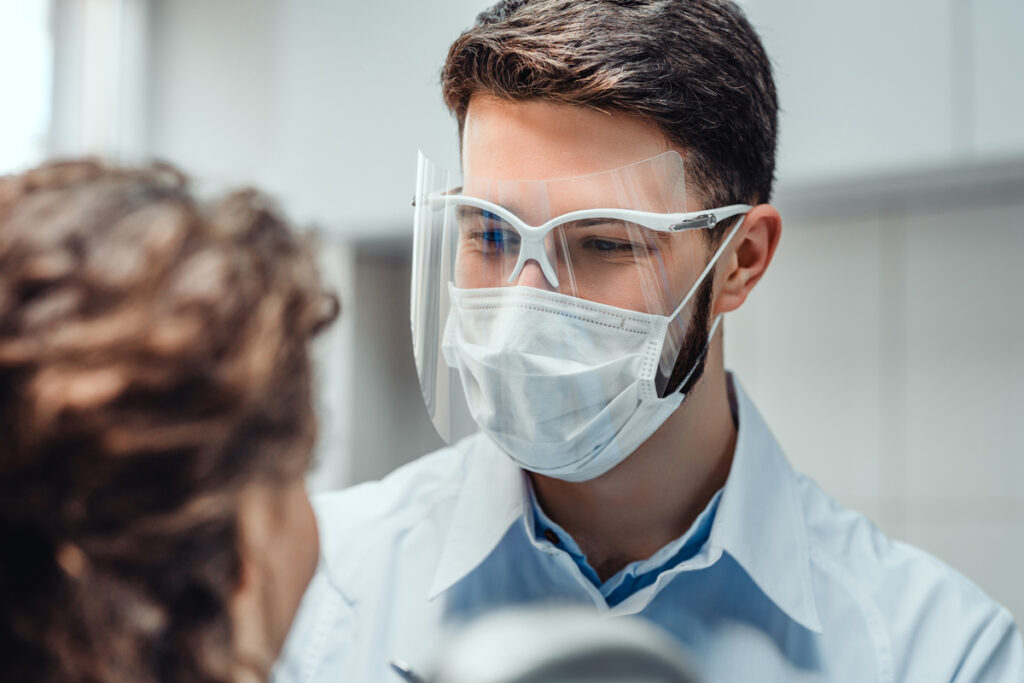
Summary/Conclusion
The importance of universal source control is quite clear in the dental healthcare setting to mitigate the spread of the SARS-CoV-2 virus. This is the new safety and infection prevention term for dentistry! Share this new term and its meaning with colleagues, team members and patients and practice what you preach, not only in the dental workplace setting but in public venues as well. The best way to prevent COVID-19 illness is to avoid being exposed to this virus. In addition to wearing a mask and practicing universal source control, the CDC recommends everyday preventive actions, including staying home if you have been exposed or are sick, staying at least 6 feet apart from others, and hand hygiene in order to help prevent the spread of respiratory diseases.8
| Exposure | Personal Protective Equipment Used | Work Restrictions |
| HCP who had prolonged close contact with a patient, visitor, or HCP with confirmed COVID-19 | HCP not wearing a respirator or facemask HCP not wearing eye protection if the person with COVID-19 was not wearing a cloth face covering or facemask HCP not wearing all recommended PPE (i.e., gown, gloves, eye protection, respirator) while performing an aerosol-generating procedure1 | Exclude from work for 14 days after last exposure Advise HCP to monitor themselves for fever or symptoms consistent with COVID-19 Any HCP who develop fever or symptoms consistent with COVID-19 should immediately contact their established point of contact (e.g., occupational health program) to arrange for medical evaluation and testing. |
| HCP other than those with exposure risk described above | N/A | No work restrictions Follow all recommended infection prevention and control practices, including wearing a facemask for source control while at work, monitoring themselves for fever or symptoms consistent with COVID-19 and not reporting to work when ill, and undergoing active screening for fever or symptoms consistent with COVID-19 at the beginning of their shift. Any HCP who develop fever or symptoms consistent with COVID-19 should immediately self-isolate and contact their established point of contact (e.g., occupational health program) to arrange for medical evaluation and testing. |
References:
1. Occupational Safety and Health Administration. Bloodborne Pathogens Standard 1910.1030. Frequently asked questions. Available at https://www.osha.gov/laws-regs/standardinterpretations/1993-02-01-0#:~:text=On%20December%206%2C%201991%2C%20the,Hepatitis%20B%20Virus%20(HBV). Accessed September 14, 2020.
2. Occupational Safety and Health Administration. Bloodborne Pathogens Standard 1910.1030. Available at https://www.osha.gov/laws-regs/regulations/standardnumber/1910/1910.1030. Accessed September 14, 2020.
3. Miller CH, Palenik CJ. Infection Control and Management of Hazardous Materials for the Dental Team. 5th ed. St. Louis: Mosby Elsevier; 2013;82.
4. Centers for Disease Control and Prevention. Infection Control. History of guidelines for isolation precautions in hospitals. Available at https://www.cdc.gov/infectioncontrol/guidelines/isolation/appendix/history.html. Accessed September 14, 2020.
5. Centers for Disease Control and Prevention. Interim Infection Prevention and Control Guidance for Dental Settings During the Coronavirus Disease 2019 (COVID-19) Pandemic Available at https://www.cdc.gov/coronavirus/2019-ncov/hcp/dental-settings.html. Accessed September 15, 2020.
6. Centers for Disease Control and Prevention. Interim Infection Prevention and Control Recommendations for Healthcare Personnel During the Coronavirus Disease 2019 (COVID-19) Pandemic. Available at https://www.cdc.gov/coronavirus/2019-ncov/hcp/infection-control-recommendations.html. Accessed September 15, 2020.
7. American Dental Association. Return to Work Interim Guidance Toolkit. Available at https://pages.ada.org/return-to-work-toolkit-american-dental-association. Accessed September 15, 2020.
8. Centers for Disease Control and Prevention. NIOSH Science Blog. Respiratory Protection vs. Source Control – What’s the difference? Available at https://blogs.cdc.gov/niosh-science-blog/2020/09/08/source-control/. Accessed September 15, 2020.
9. Konda A, Prakash A, Moss GA, Schmoldt M, Grant GD, Guha S. Aerosol Filtration Efficiency of Common Fabrics Used in Respiratory Cloth Masks. ACS Nano. 2020 Apr 24. PMID: 32329337
10. Ma QX, Shan H, Zhang HL, Li GM, Yang RM, Chen JM. Potential utilities of mask-wearing and instant hand hygiene for fighting SARS-CoV-2. J Med Virol. 2020. PMID: 32232986external icon
11. Centers for Disease Control and Prevention. CDC COVID Data Tracker. Available at https://covid.cdc.gov/covid-data-tracker/#cases_totalcases. Accessed September 15, 2020.
12. Centers for Disease Control and Prevention. Interim U.S. Guidance for Risk Assessment and Work Restrictions for Healthcare Personnel with Potential Exposure to COVID-19. Available at https://www.cdc.gov/coronavirus/2019-ncov/hcp/guidance-risk-assesment-hcp.html. Accessed September 15, 2020.
13. American Dental Association. Protocols to follow if a staff or household member is COVID-19 (+). (Members only document). Updated July 21, 2020.
Dr. Katherine Schrubbe, RDH, BS, M.Ed, PhD, is an independent compliance consultant with expertise in OSHA, dental infection control, quality assurance and risk management. She is an invited speaker for continuing education and training programs for local and national dental organizations, schools of dentistry and private dental groups. She has held positions in corporate as well as academic dentistry and continues to contribute to the scientific literature. Dr. Schrubbe can be reached at kathy@schrubbecompliance.com.


